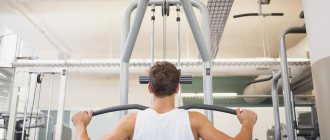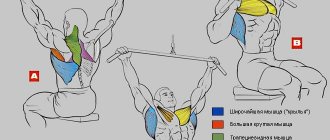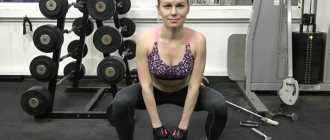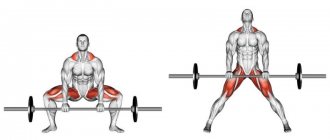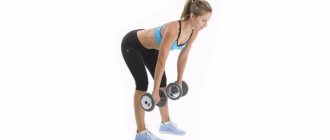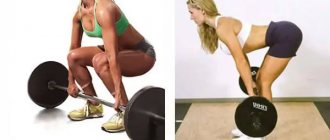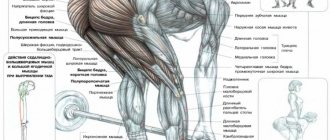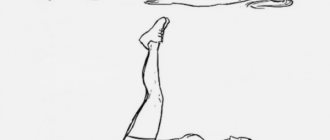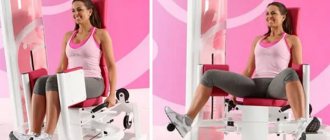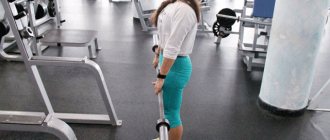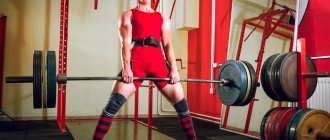Advantages and disadvantages of working in a vertical block
In continuation of what has been said about the safety of the simulator, I will clarify that the pull of the upper block does not load the spine, but, on the contrary, stretches the vertebrae thanks to the counterweight, which makes the exercise safe for diseases such as hernias, protrusions, pinched nerve endings, but only with moderate weight . Also, training on the upper block will be the right choice for beginners who have not yet strengthened their muscles, and performing barbell rows, dumbbells or other basic exercises can be traumatic.
This does not mean that exercises on a vertical block are completely safe.
If the technique is not followed, injuries to the shoulder joint are possible, which occur when the arms are sharply extended upward, which injures the joint capsule.
It is also possible to rupture the long head of the triceps , which is directly involved in bringing the arm to the chest. This can be caused by muscle overload due to excessive working weight at a time when the back muscles turn off and the triceps take on the entire load.
Following proper exercise technique and choosing the right weight will not only prevent injury, but will also improve your workout performance.
Wide grip lat pulldown to chest
The exercise develops back thickness by increasing the load on the middle of the latissimus muscles.
What muscles work
- Latissimus dorsi muscles.
- Teres major muscle.
- Biceps brachii.
- Shoulder muscles.
- Additionally included: trapezius muscle, rhomboid muscle, pectoralis major muscle.
Execution technique
- Place a wide handle on the upper block, grab it from above with a wide grip.
- Lower yourself into the seat with your arms extended above your head. Place your hips under the special fixing rollers.
- Lean your body back slightly, maintaining this position throughout the approach.
- As you exhale, bend your elbows and , using the efforts of your back muscles, bring your shoulder blades together , bringing the handle to the clavicular part of your chest, while protruding your chest, forming a deflection.
- Do not touch the sternum with the handle; fix the tension at the lowest point.
- As you inhale, smoothly straighten your elbows, maintaining the position of your body.
- At the top point, smoothly straighten your arms, gently stretching your shoulder joints, without jerking.
- Repeat the movement.
Upper pulley to the chest in video format
Read also[edit | edit code]
- Exercises for the back and shoulders (for women)
- Shoulders - exercises and training features
- Back - exercises and training features
- Raider chest thrust
- Pulling the block to the side with both hands
- Wide grip pulldown
- Seated chest row
- Standing chest row
- Seated row of block to the waist
- Block row for biceps
- Vertical block thrust
- Upper pulley to chest
- Horizontal block thrust
- Head pull on a high block
- Abdominal row on the machine
- Chin pull
- Pull the lower block forward
- Smith One Arm Row
- Standing one-arm row
Vertical block row for the head
The advantage of this exercise is to develop the width of the back muscles. This exercise prepares your back muscles for pull-ups and free weight exercises.
What muscles work
- Latissimus dorsi muscles.
- Teres major muscle.
- Biceps brachii.
- Shoulder muscles.
- Brachioradialis muscles.
- Lower part of the trapezoid.
- Rhomboid muscle.
Exercise technique
- Grab the wide handle with a wide grip from above, lower your pelvis onto the seat, straighten your arms above your head, lock your hips under the bolsters.
- Lean your body forward slightly, keeping your back straight.
- As you exhale, move the handle behind your head without touching the cervical vertebrae. Do not lower the handle below your neck. Bring your elbows towards your body by bringing your shoulder blades together, working concentratedly with your back muscles.
- Lock the muscles at the lowest point with maximum contraction.
- As you inhale, slowly straighten your arms above your head.
- Repeat the movement.
Pulldown of the upper block behind the head in video format
Reverse Grip Lat Pulldown
The exercise maximizes the thickness of the back muscles, especially the middle part. In this variant, the biceps of the shoulder are more involved in the work.
What muscles work
- Latissimus dorsi muscles.
- Teres major muscle.
- Rhomboid muscle.
- Pectoralis minor muscle.
- Shoulder biceps.
- Brachial muscle.
Exercise technique
- Place your palms on a wide bar, shoulder-width apart, with a reverse underhand grip, supinating your shoulder joints.
- Lower your pelvis onto the seat, lock your hips under the bolsters, slightly tilt your body back, maintaining the position throughout the approach.
- As you exhale, squeeze your shoulder blades, bringing your elbows towards your body, lower the handle to the upper part of the pectoral muscles, but do not touch them. Concentrating on the work of the back muscles, bring the shoulder blades towards each other as close as possible due to the deflection of the chest, in other words, make the chest a “wheel”.
- Try to perform the pull not with the biceps, but concentrated with the back muscles.
- As you inhale, smoothly straighten your arms at the joints, keeping your torso tilted back.
- Repeat the movement several times.
Reverse grip lat pulldown in video format
Exercise technique:
- Grab the handle of the cable trainer and move away from it at a distance of approximately one to two meters. Your hands should be positioned on the handle of the machine wider than shoulder width (see photo).
- Move your body back at an angle of 30° and extend your arms forward. If you can’t immediately stretch your arms forward, to make the task easier, take another half step back until you reach the correct position. After this (but not before!) start the exercise.
- Perform a pull-down, keeping your arms straight so that they are as close to your body as possible. This movement should be performed while exhaling. Try to hold your hands in this position for a few seconds to feel the muscles as much as possible.
- As you inhale, smoothly raise your arms to the starting position.
Close-grip vertical pull-down (parallel)
The exercise works all parts of the latissimus dorsi and teres major muscles using a handle for a narrow parallel grip.
What muscles work
- Latissimus dorsi muscle.
- Teres major muscle.
- Biceps brachii.
- Brachial muscle.
- Brachioradialis muscle.
- Also involved: rhomboid and trapezius muscles, posterior bundles of deltoid muscles.
Features of the technology
- It is necessary to place a handle for a narrow parallel grip or an L-handle on the upper block.
- Grasp the handles and lower your pelvis onto the seat, securing your hips under the bolsters.
- Straighten your arms above your head, lengthening your spine.
- As you exhale, pull the handle toward your upper chest without touching. At the lowest point, it is important to form a deflection of the thoracic region , as if the chest is tending to the handle, bring the shoulder blades as close as possible to each other.
- As you inhale, gently release the tension, straightening your elbows completely.
- Repeat the movements.
Close-grip lat pull-down in video format
Reverse Grip Hummer Row
Making a difference
The lower part of the latissimus dorsi (usually a weak area) is the main target for working them when you change your grip to a reverse grip and keep your elbows closer to your body during the movement.
This can be done on a cable machine, but the disc-loaded Hummer version provides a smooth, fixed-path movement with a free-weight feel.
Performance
Sit on the seat and place your legs securely under the pads of the machine (lower quadriceps). Stand up and grab the inside handles of the machine with a reverse grip and lean back slightly.
Read also: Phil Heath: back training.
While contracting your back muscles and squeezing your shoulder blades together, simultaneously pull both handles down until they touch the bottom of your chest. Slowly return the weight back to your arms outstretched.
One-arm lat pulldown
This exercise will allow you to work your back muscles more effectively. When performing the exercise on one side, the weight is not distributed on both hands, but focuses on the target muscles without the help of the stronger hand. Therefore, the craving becomes more concentrated. When choosing a working weight, divide the load with which you perform two-arm rows by two. For this exercise you will need a one-handed handle or a D-handle.
What muscles work
- Latissimus dorsi muscles.
- Teres major muscle.
- Biceps brachii.
- Shoulder muscles.
- Brachioradialis muscles.
- Lower part of the trapezius muscle.
- Rhomboid muscle.
Features of the technology
- Secure and grip the handle for one hand.
- Stand sideways, turning away from your working hand, and lower your pelvis onto the seat, while you can fix one thigh with a bolster, if this is convenient.
- Straighten your arm completely, and exhale, lower the handle to your shoulder, bringing your shoulder blade closer to the center of your back and your elbow closer to your torso. In this case, the shoulder should not turn, the elbow should look down.
- As you inhale, smoothly extend your arm to the starting position and repeat the movement.
- Then turn around in the other direction and repeat the same movement.
Seated one-arm lat pulldown in video format
Description[edit | edit code]
Leaning back slightly, pull the pulley handle toward your upper chest. Pause, return to the starting position and repeat the exercise.
Recommendations for implementation
- Do not use inertial force. Movements should be slow and controlled.
- Do not contract your shoulders or raise your shoulders during the exercise. Expand your chest and lower your shoulder blades.
- Leaning back slightly allows for greater range of motion and also activates the stabilizing abdominal muscles.
- Exhale while pulling the block down.
Initial position
- Sit down on your sit bones, open your chest and straighten your back.
- Grasp the pulley handle with a wide grip.
- During the entire exercise, your feet should be pressed firmly to the floor.
- When performing block rows, maintain a stable body position.
The wide-grip pull-down uses the following muscles:
- Torso: abdominal muscles, erector spinae muscle.
- Shoulder joint: rotator cuff.
- Shoulder blade: serratus anterior, rhomboids, inferior trapezius.
- Forearms: wrist flexors.
Movement analysis[edit | edit code]
| Major joints | Elbow | Brachial | Acromioclavicular |
| Movements performed in the joints | Down: flexion. Up: extension. | Down: adduction, partial extension. Up: abduction, partial flexion. | Down: internal rotation, adduction and depression of the shoulder blades. Upward: external rotation, abduction and elevation of the shoulder blades. |
| Main muscles involved in movements | Biceps, brachialis, brachioradialis | Latissimus dorsi, teres major, pectoralis major, posterior deltoid | Rhomboid muscles, trapezius muscle |
Relationship between shoulder and scapula movements
:
- When the arm is raised to the side, two-thirds of the movement occurs at the shoulder joint (abduction) and one-third at the scapula (external rotation).
- This ratio is maintained until the hand assumes a horizontal position. When it rises above this level and, moreover, is above the head, the share of the scapula in the movements is already two-thirds.
- This movement also involves slight flexion and extension of the arm at the shoulder joint.
Exercise options
Lowering the pulley handle behind your head rather than toward your upper chest requires greater flexibility in your chest and shoulder muscles. A narrow grip shifts the load to the latissimus dorsi and teres major, a reverse grip to the biceps and long head of the triceps, a wide grip, as shown in the figure, to the posterior deltoid, teres major, subscapularis and lateral latissimus dorsi. .
What is better to do – pull-ups or lat pull-downs?
First, you need to understand that pull-ups are the pinnacle of perfection in physical fitness and not everyone can do it for various reasons. While everyone can perform lat pull-downs - both men and girls.
The vertical block row will be an excellent springboard in preparation for pull-ups, since the target muscles in these exercises are almost the same, the only difference is in the strength and capabilities of the athlete.
If we talk about effectiveness, of course, pull-ups involve more muscles, require more strength and endurance from the athlete and bring him closer to results - increased strength, muscles and endurance.
If pull-ups are feasible at least 2-3 times, they should be included in training and developed, and various rows will be additional exercises in the uniform development of the back muscles. Otherwise, rows will be the only way to strengthen your back until the muscles are ready for pull-ups.
And also read, leading exercises to pull-ups →
Top Link Options
There are several options for performing overhead pull-downs. We took a closer look at cravings for the head, where the deltoids are mainly involved. Here are the following options:
- standing on one leg in a lunge;
- sitting with straight legs;
- using flexible tapes instead of a handle - in case it is missing.
You can also do:
- pull to the chest: here the muscles between the shoulder blades (interscapular, rhomboid, trapezius) and also the pectoral muscles are more involved; the pull is performed with a similar spread of the elbows to the sides and back, but the end point is in the center of the chest;
- to the stomach: here the handle is pulled to the lower abdomen, and the latissimus muscles, rhomboids and trapezius are included in the work more than the deltoids; when performing this thrust, you do not need to go far from the crossover, the exercise is performed with straight arms, the body leans slightly back.
Small tricks:
- Elbows should not fall below shoulders;
- upon reaching the top point, spread your arms as far as possible;
- alternate between different traction options;
- monitor your breathing;
- stay at the end point for 2-3 counts;
- look straight.
The position of the back is important in the exercise: natural curves and a slight arch in the lower back should be maintained. The chest needs to be open and the shoulders should be pulled back a little.
When performing such a deadlift, mistakes often occur. Here are typical inaccuracies:
- working on inertia – reduces the load (you need to slowly release the handle and pull it up, alternating with “explosive” traction);
- look at your feet, head down;
- stooped back;
- straight legs;
- changing the position of the arms: lowering the elbows or raising them in different directions (one elbow at the beginning of the movement, the other at the end);
- connection to the work of the muscles of the forearms;
- incorrect grip - you can use the reverse one if you have enough experience, but it is undesirable to use a closed grip;
- too large a distance from the crossover - pulls the shoulders forward;
- incorrect choice of weight;
- An excessively large number of approaches and repetitions will increase the load on the joints, but will not lead to muscle growth.
